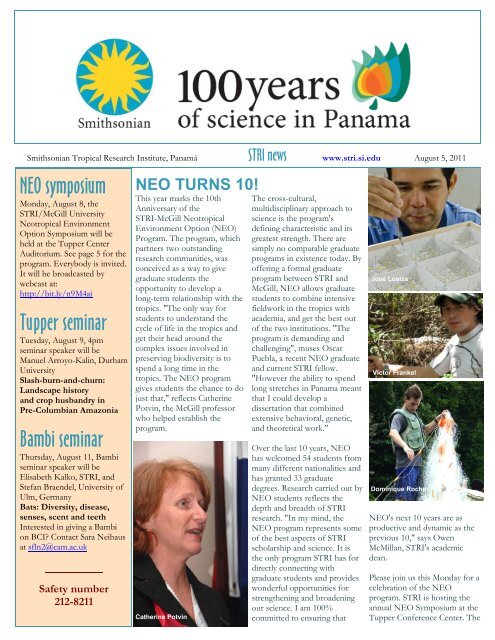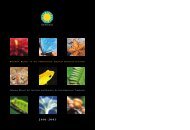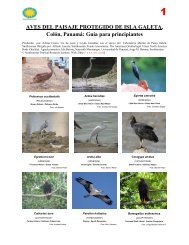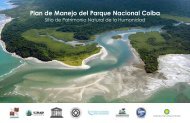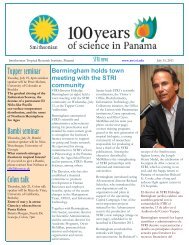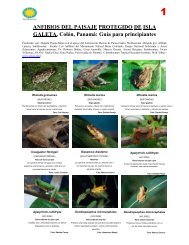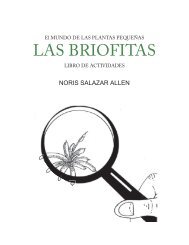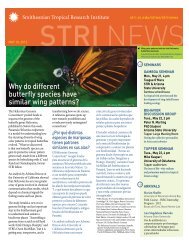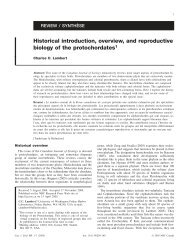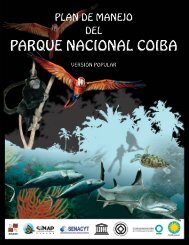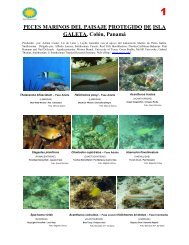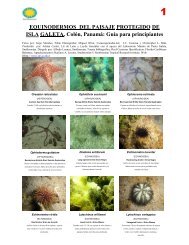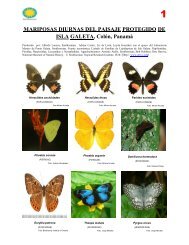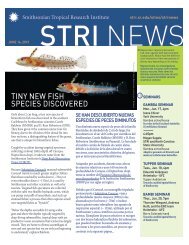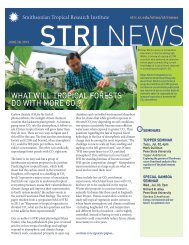NEO symposium Tupper seminar Bambi seminar - Smithsonian ...
NEO symposium Tupper seminar Bambi seminar - Smithsonian ...
NEO symposium Tupper seminar Bambi seminar - Smithsonian ...
You also want an ePaper? Increase the reach of your titles
YUMPU automatically turns print PDFs into web optimized ePapers that Google loves.
<strong>Smithsonian</strong> Tropical Research Institute, Panamá STRI news www.stri.si.edu August 5, 2011<br />
<strong>NEO</strong> <strong>symposium</strong><br />
Monday, August 8, the<br />
STRI/McGill University<br />
Neotropical Environment<br />
Option Symposium will be<br />
held at the <strong>Tupper</strong> Center<br />
Auditorium. See page 5 for the<br />
program. Everybody is invited.<br />
It will be broadcasted by<br />
webcast at:<br />
http://bit.ly/n9M4ai<br />
<strong>Tupper</strong> <strong>seminar</strong><br />
Tuesday, August 9, 4pm<br />
<strong>seminar</strong> speaker will be<br />
Manuel Arroyo-Kalin, Durham<br />
University<br />
Slash-burn-and-churn:<br />
Landscape history<br />
and crop husbandry in<br />
Pre-Columbian Amazonia<br />
<strong>Bambi</strong> <strong>seminar</strong><br />
Thursday, August 11, <strong>Bambi</strong><br />
<strong>seminar</strong> speaker will be<br />
Elisabeth Kalko, STRI, and<br />
Stefan Braendel, University of<br />
Ulm, Germany<br />
Bats: Diversity, disease,<br />
senses, scent and teeth<br />
Interested in giving a <strong>Bambi</strong><br />
on BCI? Contact Sara Neihaus<br />
at sfln2@cam.ac.uk<br />
Safety number<br />
212-8211<br />
<strong>NEO</strong> TURNS 10!<br />
This year marks the 10th<br />
Anniversary of the<br />
STRI-McGill Neotropical<br />
Environment Option (<strong>NEO</strong>)<br />
Program. The program, which<br />
partners two outstanding<br />
research communities, was<br />
conceived as a way to give<br />
graduate students the<br />
opportunity to develop a<br />
long-term relationship with the<br />
tropics. "The only way for<br />
students to understand the<br />
cycle of life in the tropics and<br />
get their head around the<br />
complex issues involved in<br />
preserving biodiversity is to<br />
spend a long time in the<br />
tropics. The <strong>NEO</strong> program<br />
gives students the chance to do<br />
just that," reflects Catherine<br />
Potvin, the McGill professor<br />
who helped establish the<br />
program.<br />
Catherine Potvin<br />
The cross-cultural,<br />
multidisciplinary approach to<br />
science is the program's<br />
defining characteristic and its<br />
greatest strength. There are<br />
simply no comparable graduate<br />
programs in existence today. By<br />
offering a formal graduate<br />
program between STRI and<br />
McGill, <strong>NEO</strong> allows graduate<br />
students to combine intensive<br />
fieldwork in the tropics with<br />
academia, and get the best out<br />
of the two institutions. "The<br />
program is demanding and<br />
challenging", muses Oscar<br />
Puebla, a recent <strong>NEO</strong> graduate<br />
and current STRI fellow.<br />
"However the ability to spend<br />
long stretches in Panama meant<br />
that I could develop a<br />
dissertation that combined<br />
extensive behavioral, genetic,<br />
and theoretical work."<br />
Over the last 10 years, <strong>NEO</strong><br />
has welcomed 54 students from<br />
many different nationalities and<br />
has granted 33 graduate<br />
degrees. Research carried out by<br />
<strong>NEO</strong> students reflects the<br />
depth and breadth of STRI<br />
research. "In my mind, the<br />
<strong>NEO</strong> program represents some<br />
of the best aspects of STRI<br />
scholarship and science. It is<br />
the only program STRI has for<br />
directly connecting with<br />
graduate students and provides<br />
wonderful opportunities for<br />
strengthening and broadening<br />
our science. I am 100%<br />
committed to ensuring that<br />
José Loaiza<br />
Victor Frankel<br />
Dominique Roche<br />
<strong>NEO</strong>'s next 10 years are as<br />
productive and dynamic as the<br />
previous 10," says Owen<br />
McMillan, STRI's academic<br />
dean.<br />
Please join us this Monday for a<br />
celebration of the <strong>NEO</strong><br />
program. STRI is hosting the<br />
annual <strong>NEO</strong> Symposium at the<br />
<strong>Tupper</strong> Conference Center. The
Arrivals<br />
Anna Strimaitis and Brendan<br />
Biggs, Florida State University,<br />
to investigate the influence of<br />
skeletal composition on<br />
growth, regeneration and<br />
reattachment of Caribbean<br />
coral reef sponges and its<br />
context-dependency, at Bocas<br />
del Toro.<br />
Janie Wulf, Florida State<br />
University, to study the<br />
influence of competition,<br />
mutualism and physical<br />
environment on patterns of<br />
sponge diversity and cooccurrence<br />
in Caribbean coral<br />
reefs and mangroves, at Bocas<br />
del Toro.<br />
Jennifer Hansen, Jonathan<br />
Stocking, Daniel Ellis,<br />
University of Virginia, to study<br />
the influence of climate change<br />
on wave dissipation over<br />
Panamanian coral reefs and<br />
subsequent effects on beach<br />
morphology, at Galeta.<br />
Frances Armstrong, College of<br />
William and Mary, to study the<br />
development of hybrid larvae<br />
from two species of Clypeaster<br />
with differing life history<br />
strategies, at Bocas del Toro.<br />
Hannah Schedkenbach and<br />
Beate Zimmermann,<br />
University of Postdam, to join<br />
the Agua Salud Project-<br />
Hydrologic Studies.<br />
Rosalien Jezeer and Leonie<br />
Wezendonk, University of<br />
Utrecht, The Netherlands, to<br />
join the Agua Salud-<br />
Hydrologic Studies Project.<br />
Anindo Choudhury, Chase<br />
Brosseau and Eric Gale, Saint<br />
Norbert College, to study<br />
freshwater fish parasites in the<br />
Chagres River watershed, in<br />
Gamboa.<br />
event begins at 9:00am and<br />
includes talks by <strong>NEO</strong> alums,<br />
as well as current <strong>NEO</strong><br />
students. McGill's Dr. Margaret<br />
Kalacska will give the keynote<br />
address. There will be a<br />
barbeque following the<br />
<strong>symposium</strong>. All are welcome.<br />
Este año marca el décimo<br />
aniversario del Programa de la<br />
Opción Ambiental Neotropical<br />
de STRI y la Universidad de<br />
McGill (<strong>NEO</strong>). El programa,<br />
para el cual se asociaron dos<br />
comunidades de investigación<br />
prestigiosas, se creó para<br />
ofrecerles a estudiantes<br />
graduados la oportunidad de<br />
desarrollar una relación a largo<br />
plazo con los trópicos. “La<br />
única manera que los<br />
estudiantes entiendan el ciclo de<br />
la vida en los trópicos y se<br />
compenetren con los complejos<br />
procesos de preservar la<br />
biodiversidad es que pasen un<br />
período largo en los trópicos.<br />
El programa <strong>NEO</strong> le ofrece a<br />
los estudiantes la oportunidad<br />
de hacer exactamente eso,”<br />
reflexiona Catherine Potvin, la<br />
profesora de McGill que ayudó<br />
a establecer el programa.<br />
Un enfoque interdiciplinario<br />
hacia la ciencia es la característica<br />
que más define al programa<br />
Oscar Puebla<br />
Kecia Kerr<br />
y representa su mayor fortaleza.<br />
Simplemente, en la actualidad<br />
no hay ningún programa de<br />
posgrado que se le compare. Al<br />
ofrecer este programa de<br />
postrado entre STRI y McGill,<br />
<strong>NEO</strong> le permite a los<br />
estudiantes combinar trabajo de<br />
campo intensivo en los trópicos<br />
con academia, y obtener lo<br />
mejor de ambas instituciones.<br />
“El programa es<br />
exigente y tiene<br />
muchos retos”<br />
comenta Oscar Puebla,<br />
un becario de STRI<br />
recientemente<br />
graduado de <strong>NEO</strong>.<br />
“Sin embargo, la<br />
posibilidad de pasar<br />
largos períodos en<br />
Panamá significó que<br />
pudiera desarrollar una<br />
tesis que combina<br />
trabajo extensivo en<br />
comportamiento,<br />
genética y teoría.”<br />
Durante los últimos<br />
diez años, <strong>NEO</strong> ha<br />
recibido a 54<br />
estudiantes de varias<br />
nacionalidades y ha<br />
otorgado 33 diplomas<br />
de postgrado. Las<br />
investigaciones llevadas<br />
a cabo por estudiantes<br />
de <strong>NEO</strong> reflejan la profundidad<br />
y amplitud de las<br />
investigaciones de STRI. “Para<br />
mí, el Programa <strong>NEO</strong><br />
representa algunos de los<br />
mejores aspectos de la<br />
erudición y ciencia de STRI.<br />
“Es el único programa que<br />
STRI posee para conectarse<br />
directamente con estudiantes<br />
graduados y ofrece magníficas<br />
oportunidades para reforzar y<br />
ampliar nuestra ciencia. Estoy<br />
comprometido ciento por<br />
ciento a asegurar que los<br />
próximos diez años de <strong>NEO</strong><br />
sean tan productivos y<br />
dinámicos como los diez años<br />
previos, aseguró Owen<br />
McMillan, decano académico de<br />
STRI.<br />
Ünanse a nosotros este lunes<br />
para la celebración del<br />
programa <strong>NEO</strong>. STRI<br />
presentará el Simposio de <strong>NEO</strong><br />
en el Centro de Conferencias<br />
<strong>Tupper</strong>. El evento empieza a las<br />
9am, e incluye charlas de<br />
graduados de <strong>NEO</strong> así como<br />
estudiantes que cursan el<br />
programa actualmente.<br />
Margaret Kalacska de McGill<br />
ofrecerá la conferencia<br />
magistral. Ofreceremos una<br />
barbacoa después del simposio.<br />
Todos están invitados.
More arrivals<br />
Martyn Slot, University of<br />
Florida, to study temperature<br />
responses of leaf dark<br />
respiration and their<br />
implication for tropical forest<br />
carbon balance, at <strong>Tupper</strong> and<br />
Gamboa.<br />
Whitney Nagel, University of<br />
North Carolina, to study<br />
ecological impact and<br />
parasitism in the invasive<br />
lionfish, Pterois volitans, in<br />
Panamanian coasts, at Bocas<br />
del Toro and Galeta.<br />
Alex Pasquini, University of<br />
North Carolina, to study<br />
molecular evolution of sea<br />
urchins, at Bocas del Toro<br />
and Naos Island Laboratories.<br />
Maryna Lesoway, McGill<br />
University, to study the<br />
evolutionary biology of the<br />
Calyptraeid gastropods, at<br />
Naos Island Laboratories.<br />
STRI in the news<br />
“ScienceShot: A buzz in the<br />
dark” by Sara Reardon. 2011.<br />
Science NOW (July 26):<br />
http://news.sciencemag.org/s<br />
ciencenow/2011/07/sciences<br />
hot-a-buzz-in-the-dark.html<br />
New publications<br />
Chisholm, Ryan A. 2011.<br />
"Time-dependent solutions of<br />
the spatially implicit neutral<br />
model of biodiversity."<br />
Theoretical Population Biology<br />
80(2): 71-79.<br />
Glynn, Peter William, Colley,<br />
Susan B., Guzman, Hector<br />
M., Enochs, Ian C., Cortes,<br />
Jorge, Mate T., Juan L., and<br />
Feingold, J.S. 2011. "Reef<br />
coral reproduction in the<br />
eastern Pacific: Costa Rica,<br />
Panama, and the Galapagos<br />
Islands (Ecuador). VI.<br />
Agariciidae, Pavona clavus."<br />
Marine Biology 158(7):<br />
1601-1617.<br />
Back-packing toucans assist<br />
tropical researchers<br />
Nutmeg-loving toucans wearing<br />
GPS transmitters recently helped<br />
a team of scientists at STRI<br />
address an age-old problem in<br />
plant ecology: Accurately<br />
estimating seed dispersal. The<br />
tracking data revealed what<br />
scientists have long suspected:<br />
toucans are excellent seed<br />
dispersers, particularly in the<br />
morning.<br />
The researchers collected fresh<br />
seeds from a common<br />
Panamanian nutmeg tree and fed<br />
them to captive toucans at the<br />
Rotterdam Zoo. They gulp<br />
nutmeg seeds whole, the outer<br />
pulp is processed in the bird's<br />
crop, and the hard inner seed is<br />
then regurgitated. Five zoo<br />
toucans fed 100 nutmeg seeds<br />
took an average of 25.5 minutes<br />
to process and regurgitate the<br />
seeds.<br />
In Panama, the scientists netted<br />
six wild toucans that were<br />
feeding from a large nutmeg tree<br />
in Gamboa. They fitted the birds<br />
with lightweight backpacks<br />
containing GPS tracking devices<br />
and accelerometers which can<br />
measure a bird's daily activity<br />
level. When matched with the<br />
seed-regurgitation time of the<br />
zoo toucans, the GPS data<br />
indicated the wild toucans were<br />
probably dropping nutmeg seeds<br />
a distance of 472 feet, on<br />
average, from the mother tree.<br />
Each seed had a 56% probability<br />
of being dropped at least 328 feet<br />
from its mother tree and an 18%<br />
chance of being dropped some<br />
656 feet from the tree.<br />
In addition, the accelerometer<br />
revealed that the toucans' peak<br />
activity and movement was in the<br />
morning followed by a lull at<br />
midday, a secondary activity peak<br />
in the afternoon, and complete<br />
inactivity at night. This is a<br />
normal pattern of tropical birds.<br />
"Time of feeding had a strong<br />
influence on seed dispersal," the<br />
scientists write. "Seeds ingested<br />
in morning (breakfast) and<br />
afternoon (dinner) were more<br />
likely to achieve significant<br />
dispersal than seeds ingested<br />
mid-day (lunch)." This<br />
observation explains why tropical<br />
nutmegs are "early morning<br />
specialists" with fruits that<br />
typically ripen at early and<br />
mid-morning so they are quickly<br />
removed by birds. Ideally, the<br />
scientists observed, nutmeg trees<br />
could increase their seed<br />
dispersal distances by producing<br />
fruit with gut-processing times of<br />
around 60 minutes.<br />
The article produced from this<br />
research was published by Kays<br />
et al, 2011. See citation under<br />
“New publications.” The article<br />
can be obtained from<br />
calderom@si.edu<br />
Tucanes que adoran la nuez<br />
moscada y portando transmisores<br />
GPS ayudaron a un equipo de<br />
científicos de STRI a resolver un<br />
antigua dilema de la ecología<br />
vegetal: estimar con exactitud la<br />
dispersión de semillas. La<br />
información que recogieron<br />
reveló lo que los científicos<br />
habían suspechado: los tucanes<br />
son excelentes dispersadores de<br />
semillas, especialmente en la<br />
mañana.<br />
Los investigadores colectaron<br />
semillas frescas de un árbol de<br />
nuez moscada común de Panamá<br />
y se las dieron a tucanes en<br />
cautiverio en el Zoológico de<br />
Rotterdam, los cuales se tragan<br />
las semillas enteras, procesan la<br />
pulpa exterior en el buche y<br />
luego regurgitan la dura semilla<br />
interior. Cinco tucanes se<br />
comieron 100 semillas de nuez<br />
moscada y les tomó en promedio<br />
25.5 minutos procesar y<br />
regurgitar las semillas.<br />
En Panamá, los científicos<br />
atraparon con redes seis tucanes<br />
silvestres que estaban<br />
alimentándose de un árbol<br />
grande de nueces en Gamboa.<br />
Les pusieron unas mochilitas que<br />
contenían transmisores GPS de<br />
poco peso y acelerómetros que<br />
miden el nivel de la actividad<br />
diaria del ave. Al comparar el<br />
tiempo en que los tucanes del<br />
zoológico regurgitan las semillas,<br />
la información del GPS indicó<br />
que los tucanes silvestres<br />
probablemente dejaban caer las<br />
semillas a una distancia de unos<br />
472 pies del árbol. Cada semilla<br />
tuvo un 56% de probabilidades<br />
de llegar por lo menos a 328 pies<br />
de distancia del árbol y 18% de<br />
llegar hasta a 656 pies del árbol.<br />
Además, el acelerómetro reveló<br />
que la máxima actividad del<br />
tucán es en la mañana, seguida de<br />
un intervalo al mediodía, una<br />
actividad alta secundaria en la<br />
tarde, y total inactividad de<br />
noche. Este es el patrón normal<br />
de las aves tropicales.<br />
“El tiempo de alimentación tiene<br />
una fuerte influencia en la<br />
dispersión de las semillas,”<br />
escribieron los investigadores.<br />
“Las semillas que se comen en la<br />
mañana (desayuno) y en la tarde<br />
(cena) tienen mayores<br />
posibilidades de dispersarse que<br />
las semillas que ingieren a<br />
mediodía (almuerzo). Esta<br />
observación explica por qué la<br />
nuez moscada tropical es un<br />
“especialista matutino” con<br />
frutas que maduran típicamente<br />
temprano y a media mañana para<br />
que las aves se las lleven. Lo<br />
ideal, observan los científicos,<br />
sería que los árboles de nuez<br />
moscada produjeran frutas con<br />
un tiempo de procesamiento en<br />
los intestinos de unos 60<br />
minutos.
New publications<br />
Jaramillo, Carlos A., Rueda,<br />
Milton, and Torres, Vladimir.<br />
2011. "A palynological<br />
zonation for the Cenozoic of<br />
the Llanos and Llanos<br />
foothills of Colombia."<br />
Palynology 35(1): 46-84.<br />
Kays, Roland, Jansen, Patrick<br />
A., Knecht, Elise M.H.,<br />
Vohwinkel, Reinhard, and<br />
Wikelski, Martin. 2011. "The<br />
effect of feeding time on<br />
dispersal of Virola seeds by<br />
toucans determined from<br />
GPS tracking and<br />
accelerometers." Acta<br />
Oecologica doi:<br />
10.1016/j.actao.2011.06.007<br />
Lambert, Thomas D.,<br />
Halsey, Michaela K., Dittel,<br />
Jacob W., Mangan, Scott A.,<br />
Delfosse, Erika, Adler,<br />
Gregory H., and Schnitzer,<br />
Stefan A. 2011. "First record<br />
of Alston´s Woolly Mouse<br />
Opossum (Micoreus alstoni)<br />
from the canal area of<br />
Central Panama." Mammalia<br />
75(1): 107-109.<br />
Mascaro, Joseph, Asner,<br />
Gregory P., Muller-Landau,<br />
Helene, Van Breugel,<br />
Michiel, Hall, Jefferson S.,<br />
and Dahlin, K. 2011.<br />
"Controls over aboveground<br />
forest carbon density on<br />
Barro Colorado Island,<br />
Panama." Biogeosciences 8(6):<br />
1615-1629.<br />
Moreno, Cufemio,<br />
Varughese, Titto, Spadafora,<br />
Carmenza, Arnold, A.<br />
Elizabeth, Coley, Phyllis D.,<br />
Kursar, Thomas A.,<br />
Gerwick, William H., and<br />
Cubilla-Rios, Luis. 2011.<br />
"Chemical constituents of<br />
the new endophytic fungus<br />
Mycosphaerella sp. nov. and<br />
their anti-parasitic activity."<br />
Natural Product Communications<br />
6(6): 835-840.<br />
Nocturnal bees<br />
see the light?<br />
Even at night, some bees are still out<br />
there, watching you with their dark<br />
vision. Three genera of Neotropical<br />
bees—Megalopta, Megaloptidia, and<br />
Megommation—eschew the sunshine,<br />
colorful flora (and predatory birds),<br />
and prowl instead for the few flowers<br />
that bloom in the moonlight.”<br />
(Reardon, ScienceNOW, 2011)<br />
A group of researchers, led by Simon<br />
Tierney (in the photo), published the<br />
article “Photic niche invasions:<br />
phylogenetic history of the dim-light<br />
foraging augochlorine bees<br />
(Halictidae)” in the Proceedings of the<br />
Royal Society B last week. For the study,<br />
they collected many of these<br />
nocturnal bees to study their DNA,<br />
specifically opsin genes which are<br />
involved in vision.<br />
Having analysed their DNA and<br />
comparing it to close relatives, the<br />
group, that includes Oris Sanjur,<br />
Gretchen Grajales, Biff Bermingham<br />
and Bill Wcislo of STRI, and Leandro<br />
Santos from Universidade Federal do<br />
Paraná, found that one of them<br />
returned to daylight foraging<br />
approximately 4 million years ago!<br />
“Maybe it was afraid of the dark”<br />
concludes Sara Reardon, in “A buzz<br />
in the dark”. You may obtain the<br />
article by Tierney et al, from<br />
calderom@si.edu<br />
“Aún de noche, algunas abejas todavía<br />
están por allí observándote con su<br />
visión nocturna. Tres géneros de<br />
abejas neotropicales, Megalopta,<br />
Megaloptidia y Megommation, evitan<br />
la luz del sol, la flora colorida (y<br />
las aves depredadoras),<br />
prefieriendo visitar las pocas flores<br />
que florecen a la luz de la luna.”<br />
(Reardon, ScienceNOW, 2011).<br />
Un grupo de científicos encabezados<br />
por Simon Tierney (foto)<br />
publicó “Photic niche invasions:<br />
phylogenetic history of the<br />
dim-light foraging augochlorine<br />
bees” en Proceedings of the Royal<br />
Society B la semana pasada. Para el<br />
estudio, colectaron muchas de<br />
estas abejas nocturnas y<br />
estudiaron su ADN, en particular<br />
los genes opsin que tienen que ver<br />
con la visión.<br />
Luego de analizar el ADN y<br />
compararlos con parientes, el<br />
grupo, que incluye a Oris Sanjur,<br />
Gretchen Grajales, Biff<br />
Bermingham y Bill Wcislo, de<br />
STRI, y Leandro Santos de la<br />
Universidad Federal de Paraná,<br />
encontraron que hace unos 4<br />
millones de años, una de estas<br />
abejas, regresó a forrajear de día<br />
“Quizá le temía a la oscuridad”<br />
concluyó Reardon en “A buzz in<br />
the dark” [Zumbido en la<br />
Oscuridad]. Para el artículo de<br />
Tierney et al de calderom@si.edu<br />
New publications<br />
Powell, Scott. 2011. "How<br />
much do army ants eat? On<br />
the prey intake of a<br />
Neotropical top-predator."<br />
Insectes Sociaux 58(3):<br />
317-324.<br />
Serrano, Lina, Ferrari, Luca,<br />
Martinez, Margarita Lopez,<br />
Petrone, Chiara Maria, and<br />
Jaramillo, Carlos. 2011. "An<br />
integrative geologic,<br />
geochronologic and<br />
geochemical study of<br />
Gorgona Island, Colombia:<br />
Implications for the<br />
formation of the Caribbean<br />
Large Igneous Province."<br />
Earth and Planetary Science<br />
Letters<br />
doi.org/10.1016/j.epsl.2011.<br />
07.011<br />
Update, 2010<br />
Lambert, Adam M., Dudley,<br />
Tom L., and Saltonstall,<br />
Kristin. 2010. "Ecology and<br />
impacts of the large-statured<br />
invasive grasses Arundo<br />
donax and Phragmites<br />
australis in North America."<br />
Invasive Plant Science and<br />
Management 3(4): 489-494.<br />
doi:10.1614/ipsm-d-10-00031.1<br />
Meyerson, Laura A.,<br />
Lambert, Adam M., and<br />
Saltonstall, Kristin. 2010. "A<br />
tale of three lineages:<br />
Expansion of common reed<br />
(Phragmites australis) in the<br />
U.S. Southwest and Gulf<br />
Coast." Invasive Plant Science<br />
and Management 3(4):<br />
515-520.<br />
doi:10.1614/ipsm-d-09-00052.1<br />
Saltonstall, Kristin, Lambert,<br />
Adam, and Meyerson, Laura<br />
A. 2010. "Genetics and<br />
reproduction of common<br />
(Phragmites australis) and<br />
Giant Reed (Arundo donax)."<br />
Invasive Plant Science and<br />
Management 3(4): 495-505.<br />
doi:10.1614/ipsm-09-053.1
<strong>NEO</strong> ANNUAL SYMPOSIUM<br />
Neotropical Environment Option<br />
STRI-McGill University<br />
AUGUST 8, 2011<br />
9 am Owen McMillan, STRI Welcoming words<br />
9:15 am Oscar Puebla, Postdoc,<br />
Life after <strong>NEO</strong><br />
former <strong>NEO</strong> student<br />
9:45 am Alana Domingo, Biology<br />
Ph.D. student<br />
10:15 am Sophie Picq, Biology<br />
Master student<br />
10:30-10:45 am COFFEE BREAK<br />
10:45 am Maryna Lesoway, Biology<br />
Ph.D. student<br />
11:15 am Victor Frankel, Biology<br />
Ph.D. student<br />
11:45 am Guillaume Dury, Plant Science<br />
Master student<br />
12-2 pm LUNCH<br />
2 pm Luis Fernando De León,<br />
former <strong>NEO</strong> student, McGill<br />
Postdoc Redpath Museum<br />
2:30 pm Stéphanie Sabbagh<br />
Natural Resources<br />
Master student<br />
2:45 pm Guillaume Petersen St. Laurent,<br />
Biology Master student<br />
3 pm Gerardo Vergara Asenjo,<br />
Biology Ph.D. student<br />
3:30-3:45 pm COFFEE BREAK<br />
3:45 pm Margaret Kalacska,<br />
McGill Faculty<br />
KEYNOTE SPEAKER<br />
Linking larval and adult fish<br />
communities in marine protected<br />
areas in the Pacific of Panama<br />
Relationship between genetic distances<br />
and communication behaviour in one<br />
species of weakly electric fish,<br />
Brachyhypopomus occidentalis<br />
MAPK activation and early development<br />
in the Calyptraeid gastropods<br />
Using biological invasions to test<br />
ecological and evolutionary drivers<br />
of host-parasite interactions<br />
Evolution of larval aggregation in<br />
neotropical Chrysomeline leaf beetles<br />
Anthropogenic impacts on evolutionary<br />
diversification in Darwin’s finches<br />
Social Factors Affecting Shark Conservation<br />
on the Mesoamerican Barrier Reef<br />
REDD+ and the agricultural frontier:<br />
Understanding colonos uses of the territory<br />
Evaluating forest carbon stocks<br />
and stocks changes in Panama:<br />
the role of indigenous peoples<br />
in forest conservation<br />
Hyperspectral remote sensing in the<br />
Neoptropics - from ecology to forensics.<br />
Live webcast at<br />
http://bit.ly/n9M4ai
When was the last time you heard that<br />
a large group of people leaves such<br />
a small beach clean?<br />
<strong>Smithsonian</strong> Tropical Research Institute, August 5, 2011<br />
Three hundred people<br />
showed up on Sunday,<br />
July 31, for the second<br />
beach cleaning at<br />
STRI's Galeta Marine<br />
Laboratory, organized<br />
by Maya de Vries,<br />
Fullbright fellow doing<br />
research at Galeta.<br />
The group included US<br />
ambassador in<br />
Panama Phyllis<br />
Powers, groups of<br />
Young Ambassadors<br />
from Panama and<br />
Young Leadership<br />
from the US, students<br />
from Florida State<br />
University in Panama<br />
and Eben-Ezer<br />
High-School in Colon,<br />
HSBC volunteers and<br />
yongsters from Coco<br />
Solo, as well as STRI<br />
researchers.<br />
“With the increase of<br />
scientific work at<br />
Galeta, the number of<br />
visitors is larger and<br />
social work and<br />
environmental<br />
awareness also<br />
increases in the<br />
community” stated<br />
Stanley Heckadon-<br />
Moreno, STRI director<br />
for Communication<br />
and Public Programs.<br />
The crowd collected<br />
some 150 garbage<br />
bags. The next beach<br />
cleaning will be held in<br />
September.<br />
The inset photo<br />
shows, from the left,<br />
STRI intern Andrew<br />
Sellers, Maya de Vries,<br />
Alice Brown from the<br />
US Embassy, and<br />
ambassador Powers.<br />
Trecientas personas<br />
aparecieron el<br />
domingo 31 de julio<br />
para la segunda<br />
limpieza de playa<br />
llevada a cabo en el<br />
Laboratorio Marino de<br />
Galeta, organizado por<br />
Maya de Vries, becaria<br />
Fullbright que realiza<br />
investigaciones en<br />
Galeta.<br />
El grupo incluyó a la<br />
embajadora de los<br />
Estados Unidos en<br />
Panamá, Phyllis<br />
Powers, grupos de los<br />
Embajadores Jóvenes<br />
de Panamá y Young<br />
Leadership de Estados<br />
Unidos, estudiantes de<br />
Florida State<br />
University y Colegio<br />
Eben-Ezer en Colon,<br />
jóvenes de Coco Solo,<br />
voluntarios del Banco<br />
HSBC, y científicos de<br />
STRI.<br />
“Con el aumento de<br />
trabajo científico en<br />
Galeta, el número de<br />
visitantes es mayor, y<br />
el trabajo social y la<br />
conciencia ambiental<br />
aumenta entre la<br />
comunidad” afirmó<br />
Stanley Heckadon-<br />
Moreno, director de<br />
Comunicaciones y<br />
Programas Públicos<br />
de STRI.<br />
Los visitantes<br />
recogieron unas 150<br />
bolsas de basura. La<br />
próxima limpieza de<br />
Galeta se llevará a<br />
cabo en Septiembre.<br />
La foto a la derecha<br />
muestra (desde la<br />
izquierda) a Andrew<br />
Sellers, pasante en<br />
STRI, Maya de Vries,<br />
Alice Brown de la<br />
Embajada de los EU y<br />
a la embajadora<br />
Powers.


